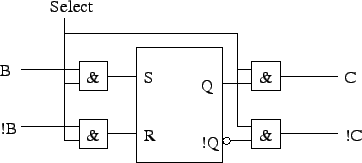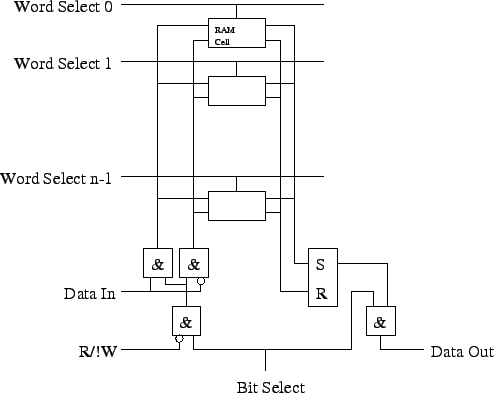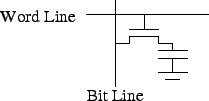Inside RAM
Tom Kelliher, CS 240
May 7, 2008
Final: Tuesday, May 13, 3:00-5:00 pm.
None.
Introduction to memory; ROM; FLASH.
- Introduction.
- Static RAM.
- Dynamic RAM.
Final.
- Organizations of RAMs: number of words, bits/word.
- Operation:
- Not enabled: low power mode, output in high-impedance state
(disconnected)
- Read: A single word should be read. Address may change.
- Write: A single word should be written. Address must be stable.
- Refresh. Hidden or not hidden?
- RAM will have a 2-D structure: row/word, column/bit.
The number of columns may not have anything to do with bits/word -- many
RAMs have 1 bit/word but are 2-D internally.
- RAMS consist of:
- Storage cells.
- Word and bit decoders.
- Write logic.
- Read logic (sense amp).
- Refresh logic for DRAMs.
- Memory cell model:
Goal: cell should be as small as possible, to increase storage density.
Think about the AND gates on the output side as tri-state buffers --
transmission gates.
- Bit slice of a RAM array:
- Assume you have
 bit-slice RAM cells. Adding 2-to-4
decoders, how would a
bit-slice RAM cells. Adding 2-to-4
decoders, how would a  RAM look? A
RAM look? A  RAM?
RAM?
- DRAM cell:
- SRAM cell: five or six transistors. DRAM cell: one transistor and
one capacitor.
- Bit-Slice: support structure similar.
- Bit line has higher capacitance than storage capacitor -- sense amps.
- Destructive read. Use of sense amps to restore data.
- Refresh due to leakage. Refresh logic.
Thomas P. Kelliher
2008-05-05
Tom Kelliher




